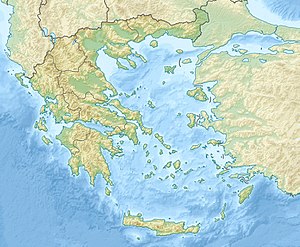
Back Schlacht von Spartolos German Μάχη στη Σπάρτωλο Greek Batalla de Calcídica Spanish Bataille de Chalcis French Battaglia di Calci Italian スパルトロスの戦い Japanese Slag bij Spartolos Dutch Slaget ved Khalkis NB Битва при Спартоле Russian Bitka kod Halkide Serbo-Croatian
This article needs additional citations for verification. (July 2008) |
| Battle of Spartolos | |||||||
|---|---|---|---|---|---|---|---|
| Part of the Peloponnesian War | |||||||
| |||||||
| Belligerents | |||||||
| Athens | |||||||
| Commanders and leaders | |||||||
| Xenophon†[1] | Unknown | ||||||
| Strength | |||||||
| 2,000 infantry, 200 cavalry[2] | 5,000 infantry, 400 cavalry | ||||||
| Casualties and losses | |||||||
| 430 dead | No more than 315 dead | ||||||
Location of the Battle of Spartolos | |||||||
The Battle of Spartolos took place in 429 BC between Athens and the Chalcidian League and their allies, in the early part of the Peloponnesian War.
The fall of Potidaea had not succeeded in quelling the rebellion against Athens in Chalcidice. To ensure a steady stream of imperial revenue and suppress additional local uprisings, the Athenians dispatched Xenophon (son of Euripides) with 2,000 hoplites and 200 cavalry to launch an attack on Spartolos.[3] They destroyed the crops outside the city and began negotiating with pro-Athenian factions in Chalcidice, but the anti-Athenian factions asked for help from Olynthus. An army from Chalcidice, Spartolos, and Olynthus met the Athenians in battle, but their hoplites were defeated and they retreated to Spartolos. Their cavalry and peltasts, however, gained the advantage over the Athenian troops. Reinforcements soon arrived from Olynthus, and they launched a second attack on the Athenians. The Athenian hoplites could not come to grips with the enemy light troops or horsemen. Eventually the Athenians panicked and were routed, with all of their generals and 430 other men killed.
In the Athenian tribute list of 429/8 BC the only cities of Chalcidice are: Mende, Aphytis, Scione, Stageira and Acanthus (Athos).[4] Acanthus and Mende had not even joined the Chalcidian League.
- ^ Thucydides, 2.79
- ^ Kagan, Donald (2013). A New History of the Peloponnesian War. Ithaca, NY: Cornell University Press. p. 89. ISBN 978-0-8014-6729-5.
- ^ Kagan, Donald (2013). A New History of the Peloponnesian War. Ithaca, NY: Cornell University Press. p. 89. ISBN 978-0-8014-6729-5.
- ^ IG I³ 282
